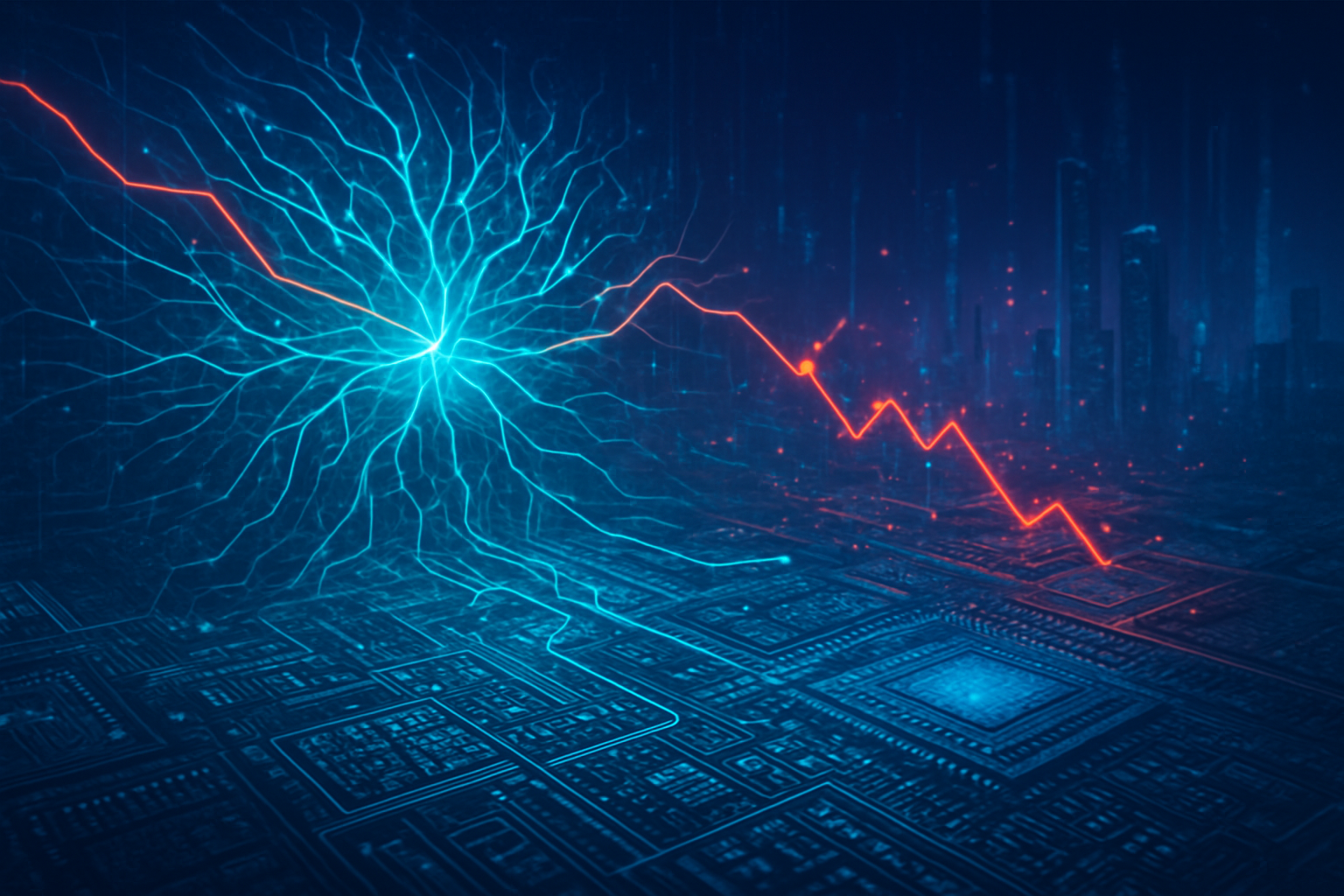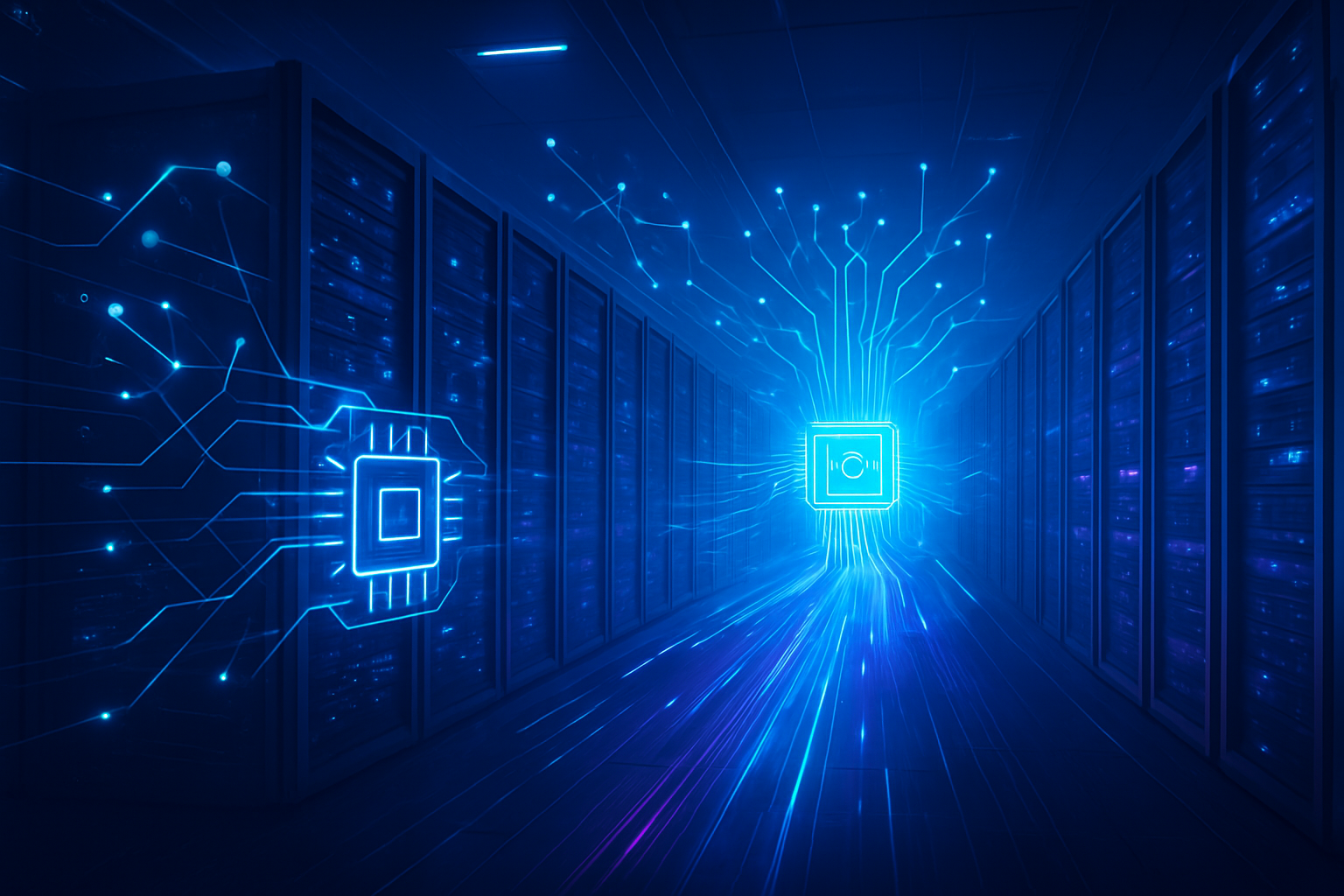The technology sector has recently been gripped by a significant selloff, particularly in late October and early November 2025, sending ripples of concern through the market. This downturn, fueled by a complex interplay of rising interest rates, persistent inflation, and anxieties over potentially stretched valuations, has had an immediate and pronounced impact on bellwether AI and chip stocks, with industry titan Nvidia (NASDAQ: NVDA) experiencing notable declines. Compounding these macroeconomic pressures were geopolitical tensions, ongoing supply chain disruptions, and the "Liberation Day" tariffs introduced in April 2025, which collectively triggered widespread panic selling and a substantial re-evaluation of risk across global markets.
This period of volatility marks a critical juncture for the burgeoning artificial intelligence landscape. The preceding years saw an almost unprecedented rally in AI-related equities, driven by fervent optimism and massive investments in generative AI. However, the recent market correction signals a recalibration of investor sentiment, with growing skepticism about the sustainability of the "AI boom" and a heightened focus on tangible returns amidst an increasingly challenging economic environment. The immediate significance lies in the market's aggressive de-risking, highlighting concerns that the enthusiasm for AI may have pushed valuations beyond fundamental realities.
The Technical Tangle: Unpacking the Decline in AI and Chip Stocks
The recent downturn in AI and chip stocks, epitomized by Nvidia's (NASDAQ: NVDA) significant slide, is not merely a superficial market correction but a complex unwinding driven by several technical and fundamental factors. After an unprecedented multi-year rally that saw Nvidia briefly touch a staggering $5 trillion market valuation in early November 2025, a pervasive sentiment of overvaluation began to take hold. Nvidia's trailing price-to-sales ratio of 28x, P/E ratio of 53.32, and P/B ratio of 45.54 signaled a richly valued stock, prompting widespread profit-taking as investors cashed in on substantial gains.
A critical contributing factor has been the escalating geopolitical tensions and their direct impact on the semiconductor supply chain and market access. In early November 2025, news emerged that the U.S. government would not permit the sale of Nvidia's latest scaled-down Blackwell AI chips to China, a market that accounts for nearly 20% of Nvidia's data-center sales. This was compounded by China's new directive mandating state-funded data center projects to utilize domestically manufactured AI chips, effectively sidelining Nvidia from a significant government sector. These export restrictions introduce considerable revenue uncertainty and cap growth potential for leading chipmakers. Furthermore, concerns regarding customer concentration and potential margin contraction, despite robust demand for Nvidia's Blackwell architecture, have also been flagged by analysts.
This market behavior, while echoing some anxieties of the dot-com bubble, presents crucial differences. Unlike many speculative internet startups of the late 1990s that lacked clear paths to profitability, today's AI leaders like Nvidia, Microsoft (NASDAQ: MSFT), Amazon (NASDAQ: AMZN), and Google (NASDAQ: GOOGL) are established giants with formidable balance sheets and diversified revenue streams. They are funding massive AI infrastructure build-outs with internal profits rather than relying on external leverage for unproven ventures. However, similarities persist in the cyclically adjusted P/E ratio (CAPE) for U.S. stocks nearing dot-com era peaks and the concentrated market gains in a few "Magnificent Seven" AI-related stocks.
Initial reactions from market analysts have been mixed, ranging from viewing the decline as a "healthy reset" and profit-taking, to stern warnings of a potential 10-20% market correction. Executives from Goldman Sachs (NYSE: GS) and Morgan Stanley (NYSE: MS) have voiced concerns, with some predicting a "sudden correction" if the AI frenzy pushes valuations beyond sustainable levels. Nvidia's upcoming earnings report, expected around November 19, 2025, is widely anticipated as a "make-or-break moment" and a "key litmus test" for investor perception of AI valuations, with options markets pricing in substantial volatility. Technically, Nvidia's stock has shown signs of weakening momentum, breaking below its 10-week and 20-week Moving Average support levels, with analysts anticipating a minimum 15-25% correction in November, potentially bringing the price closer to its 200-day MA around $150-$153. The stock plummeted over 16% in the first week of November 2025, wiping out approximately $800 billion in market value in just four trading sessions.
Shifting Sands: The Selloff's Ripple Effect on AI Companies and Tech Ecosystems
The recent tech selloff has initiated a significant recalibration across the artificial intelligence landscape, profoundly affecting a spectrum of players from established tech giants to nimble startups. While the broader market exhibits caution, the foundational demand for AI continues to drive substantial investment, albeit with a sharpened focus on profitability and sustainable business models.
Surprisingly, AI startups have largely shown resilience, defying the broader tech downturn by attracting record-breaking investments. In Q2 2024, U.S. AI startups alone garnered $27.1 billion, nearly half of all startup funding in that period. This unwavering investor faith in AI's transformative power, particularly in generative AI, underpins this trend. However, the high cost of building AI, demanding substantial investment in powerful chips and cloud storage, is leading venture capitalists to prioritize later-stage companies with clear revenue models. Competition from larger tech firms also poses a future challenge for some. Conversely, major tech giants, or "hyperscalers," such as Alphabet (NASDAQ: GOOGL), Amazon (NASDAQ: AMZN), and Microsoft (NASDAQ: MSFT), have demonstrated relative resilience. These titans are at the forefront of AI infrastructure investment, funneling billions into hardware and software, often self-funding from their robust operational cash flow. Crucially, they are aggressively developing proprietary custom AI silicon, like Google's TPUs, AWS's Trainium and Inferentia, and Microsoft's Azure Maia AI and Graviton processors, to diversify their hardware sourcing and reduce reliance on external suppliers.
AI chip manufacturers, particularly Nvidia, have absorbed the brunt of the selloff. Nvidia's stock experienced significant declines, with its market value retracting substantially due to concerns over overvaluation, a lack of immediate measurable return on investment (ROI) from some AI projects, and escalating competition. Other chipmakers, including Advanced Micro Devices (NASDAQ: AMD), also saw dips amid market volatility. This downturn is accelerating competitive shifts, with hyperscalers’ push for custom silicon intensifying the race among chip manufacturers. The substantial capital required for AI development further solidifies the dominance of tech giants, raising barriers to entry for smaller players. Geopolitical tensions and export restrictions also continue to influence market access, notably impacting players like Nvidia in critical regions such as China.
The selloff is forcing a re-evaluation of product development, with a growing realization that AI applications must move beyond experimental pilots to deliver measurable financial impact for businesses. Companies are increasingly integrating AI into existing offerings, but the emphasis is shifting towards solutions that optimize costs, increase efficiency, manage risk, and provide clear productivity gains. This means software companies delivering tangible ROI, those with strong data moats, and critical applications are becoming strategic necessities. While the "AI revolution's voracious appetite for premium memory chips" like High Bandwidth Memory (HBM) has created shortages, disrupting production for various tech products, the overall AI investment cycle remains anchored in infrastructure development. However, investor sentiment has shifted from "unbridled enthusiasm to a more critical assessment," demanding justified profitability and tangible returns on massive AI investments, rather than speculative hype.
The Broader Canvas: AI's Trajectory Amidst Market Turbulence
The tech selloff, particularly its impact on AI and chip stocks, is more than a fleeting market event; it represents a significant inflection point within the broader artificial intelligence landscape. This period of turbulence is forcing a crucial re-evaluation, shifting the industry from a phase of unbridled optimism to one demanding tangible value and sustainable growth.
This downturn occurs against a backdrop of unprecedented investment in AI. Global private AI investment reached record highs in 2024, with generative AI funding experiencing explosive growth. Trillions are being poured into building AI infrastructure, from advanced chips to vast data centers, driven by an "insatiable" demand for compute power. However, the selloff underscores a growing tension between this massive capital expenditure and the immediate realization of tangible returns. Companies are now under intense scrutiny to demonstrate how their AI spending translates into meaningful profits and productivity gains, signaling a strategic pivot towards efficient capital allocation and proven monetization strategies. The long-term impact is likely to solidify a capital-intensive business model for Big Tech, akin to hardware-driven industries, necessitating new investor metrics focused on AI adoption, contract backlogs, and generative AI monetization. A critical "commercialization window" for AI monetization is projected between 2026 and 2030, where companies must prove their returns or face further market corrections.
The most prominent concern amplified by the selloff is the potential for an "AI bubble," drawing frequent comparisons to the dot-com era. While some experts, including OpenAI CEO Sam Altman, believe an AI bubble is indeed ongoing, others, like Federal Reserve Chair Jerome Powell, argue that current AI companies possess substantial earnings and are generating significant economic growth through infrastructure investments, unlike many speculative dot-com ventures. Nevertheless, concerns persist about stretched valuations, unproven monetization strategies, and the risk of overbuilding AI capacity without adequate returns. Ethical implications, though not a direct consequence of the selloff, remain a critical concern, with ongoing discussions around regulatory frameworks, data privacy, and algorithmic transparency, particularly in regions like the European Union. Furthermore, the market's heavy concentration in a few "Magnificent Seven" tech giants, which disproportionately drive AI investment and market capitalization, raises questions about competition and innovation outside these dominant players.
Comparing this period to previous AI milestones reveals both echoes and distinctions. While the rapid pace of investment and valuation concerns "rhyme with previous bubbles," the underlying fundamentals of today's leading AI companies often boast substantial revenues and profits, a stark contrast to many dot-com startups that lacked clear business models. The demand for AI computing power and infrastructure is considered "insatiable" and real, not merely speculative capacity. Moreover, much of the AI infrastructure spending by large tech firms is funded through operational cash flow, indicating stronger financial health. Strategically, the industry is poised for increased vertical integration, with companies striving to own more of the "AI stack" from chip manufacturing to cloud services, aiming to secure supply chains and capture more value across the ecosystem. This period is a crucial maturation phase, challenging the AI industry to translate its immense potential into tangible economic value.
The Road Ahead: Future Trajectories of AI and Semiconductors
The current market recalibration, while challenging, is unlikely to derail the fundamental, long-term growth trajectory of artificial intelligence and the semiconductor sector. Instead, it is shaping a more discerning and strategic path forward, influencing both near-term and distant developments.
In the near term (1-5 years), AI is poised to become "smarter, not just faster," with significant advancements in context-aware and multimodal learning systems that integrate various data types to achieve a more comprehensive understanding. AI will increasingly permeate daily life, often invisibly, managing critical infrastructure like power grids, personalizing education, and offering early medical diagnoses. In healthcare, this translates to enhanced diagnostic accuracy, AI-assisted surgical robotics, and personalized treatment plans. The workplace will see the rise of "machine co-workers," with AI automating routine cognitive tasks, allowing humans to focus on higher-value activities. Concurrently, the semiconductor industry is projected to continue its robust growth, fueled predominantly by the insatiable demand for generative AI chips, with global revenue potentially reaching $697 billion in 2025 and on track for $1 trillion by 2030. Moore's Law will persist through innovations like Extreme Ultraviolet (EUV) lithography and novel architectures such as nanosheet or gate-all-around (GAA) transistors, promising improved power efficiency. Advanced packaging technologies like 3D stacking and chiplet integration (e.g., TSMC's CoWoS) will become critical for higher memory density and system specialization, while new materials like Gallium Nitride (GaN) and Silicon Carbide (SiC) will see increased adoption in power electronics.
Looking further ahead (5-25 years and beyond), the debate around Artificial General Intelligence (AGI) intensifies. While many researchers project human-level AGI as a distant goal, some predict its emergence under strict ethical control by 2040, with AI systems eventually rivaling or exceeding human cognitive capabilities across multiple domains. This could lead to hyper-personalized AI assistants serving as tutors, therapists, and financial advisors, alongside fully autonomous systems in security, agriculture, and potentially humanoid robots automating physical labor. The economic impact could be staggering, with AI potentially boosting global GDP by 14% ($15.7 trillion) by 2030. The long-term future of semiconductors involves a fundamental shift beyond traditional silicon. By the mid-2030s, new electronic materials like graphene, 2D materials, and compound semiconductors are expected to displace silicon in mass-market devices, offering breakthroughs in speed, efficiency, and power handling. Early experiments with quantum-AI hybrids are also anticipated by 2030, paving the way for advanced chip architectures tailored for quantum computing.
However, formidable challenges lie ahead for both sectors. For AI, these include persistent issues with data accuracy and bias, insufficient proprietary data for model customization, and the significant hurdle of integrating AI systems with existing, often legacy, IT infrastructure. The ethical and societal concerns surrounding fairness, accountability, transparency, and potential job displacement also remain paramount. For semiconductors, escalating manufacturing costs and complexity at advanced nodes, coupled with geopolitical fragmentation and supply chain vulnerabilities, pose significant threats. Talent shortages, with a projected need for over a million additional skilled workers globally by 2030, and the growing environmental impact of manufacturing are also critical concerns. Expert predictions suggest that by 2026, access to "superhuman intelligence" across various domains could become remarkably affordable, and the semiconductor industry is projected to reach a $1 trillion valuation by 2030, driven primarily by generative AI chips. The current market conditions, particularly the strong demand for AI chips, are acting as a primary catalyst for the semiconductor industry's robust growth, while geopolitical tensions are accelerating the shift towards localized manufacturing and diversified supply chains.
Comprehensive Wrap-up: Navigating AI's Maturation
The recent tech selloff, particularly its pronounced impact on AI and chip stocks, represents a crucial period of recalibration rather than a catastrophic collapse. Following an extended period of extraordinary gains, investors have engaged in significant profit-taking and a rigorous re-evaluation of soaring valuations, demanding tangible returns on the colossal investments pouring into artificial intelligence. This shift from "unbridled optimism to cautious prudence" marks a maturation phase for the AI industry, where demonstrable profitability and sustainable business models are now prioritized over speculative growth.
The immediate significance of this downturn in AI history lies in its distinction from previous market bubbles. Unlike the dot-com era, which saw speculative booms built on unproven ideas, the current AI surge is underpinned by real technological adoption, massive infrastructure buildouts, and tangible use cases across diverse industries. Companies are deploying billions into hardware, advanced models, and robust deployment strategies, driven by a genuine and "insatiable" demand for AI applications. The selloff, therefore, functions as a "healthy correction" or a "repricing" of assets, highlighting the inherent cyclicality of the semiconductor industry even amidst unprecedented AI demand. The emergence of strong international competitors, such as China's DeepSeek demonstrating comparable generative AI results with significantly less power consumption and cost, also signals a shift in the global AI leadership narrative, challenging the dominance of Western specialized AI chip manufacturers.
Looking ahead, the long-term impact of this market adjustment is likely to foster a more disciplined and discerning investment landscape within the AI and chip sectors. While short-term volatility may persist, the fundamental demand for AI technology and its underlying infrastructure is expected to remain robust and continue its exponential growth. This period of re-evaluation will likely channel investment towards companies with proven business models, durable revenue streams, and strong free cash flow generation, moving away from "story stocks" lacking clear paths to profitability. The global semiconductor industry is still projected to exceed $1 trillion in annual revenue by 2030, driven by generative AI and advanced compute chips, underscoring the enduring strategic importance of the sector.
In the coming weeks and months, several key indicators will be crucial to watch. Nvidia's (NASDAQ: NVDA) upcoming earnings reports will remain a critical barometer for the entire AI sector, heavily influencing market sentiment. Investors will also closely scrutinize the return on investment from the massive AI expenditures by major hyperscalers like Microsoft (NASDAQ: MSFT), Alphabet (NASDAQ: GOOGL), and Amazon (NASDAQ: AMZN), as any indication of misallocated capital could further depress their valuations. The Federal Reserve's decisions on interest rates will continue to shape market liquidity and investor appetite for growth stocks. Furthermore, the immense demand for AI-specific memory chips, such as High Bandwidth Memory (HBM) and RDIMM, is already causing shortages and price increases, and monitoring the supply-demand balance for these critical components will be essential. Finally, observe the competitive landscape in AI, the broader market performance, and any strategic merger and acquisition (M&A) activities, as companies seek to consolidate or acquire technologies that demonstrate clear profitability in this evolving environment.
This content is intended for informational purposes only and represents analysis of current AI developments.
TokenRing AI delivers enterprise-grade solutions for multi-agent AI workflow orchestration, AI-powered development tools, and seamless remote collaboration platforms.
For more information, visit https://www.tokenring.ai/.









